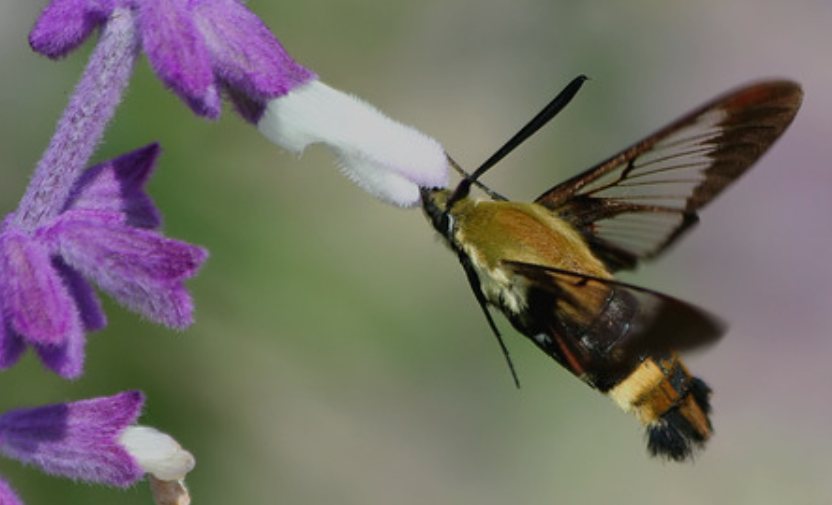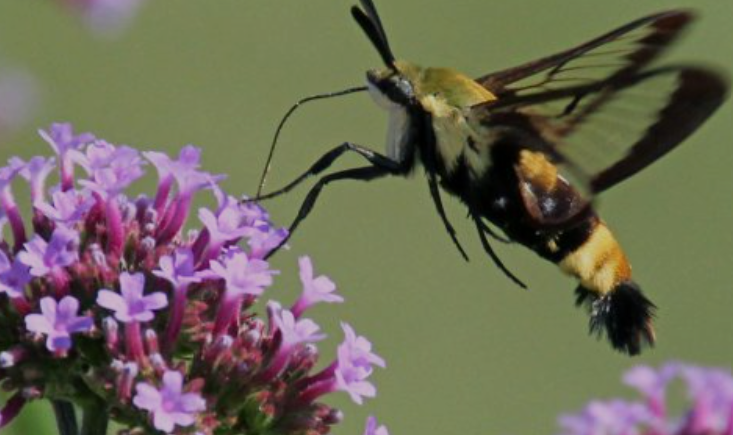
Classification
The Hummingbird Moth (Hemaris thysbe) belongs to the family Sphingidae, which includes hawk moths known for their fast flight and hovering capabilities. It is part of the genus Hemaris, a group of moths often referred to as “clearwing” or “hummingbird-like” moths due to their distinctive transparent wing sections and bird-like flight behavior. This classification places them firmly within the order Lepidoptera, alongside butterflies and other moths.
Identifying Characteristics
Adult Hummingbird Moths have a wingspan of approximately 1.8 to 2.5 inches (45–65 mm). Their forewings are brownish-green or reddish-brown, while the hindwings are reddish-orange with transparent “window” patches. Their flight closely resembles that of a hummingbird, as they hover in front of flowers while feeding on nectar. A long proboscis allows them to access deep nectar sources, making them efficient pollinators. These unique features make them easily recognizable among North American moths.
Distribution
Hemaris thysbe is native to eastern North America, including the eastern United States and southern Canada. While they are not long-distance migrants, local movements are common in response to seasonal availability of flowers. They can occasionally be observed farther west, depending on environmental conditions.
Migration & Habitat
Though not true migratory moths, Hummingbird Moths may move short distances to find suitable feeding sites throughout the spring, summer, and early fall. They thrive in habitats with abundant nectar sources, such as gardens, meadows, forest edges, and open fields. Their preference for areas rich in flowering plants makes them frequent visitors to backyards and wildflower ecosystems alike.
Predators & Threats
The Hummingbird Moth faces predation from birds, spiders, and predatory insects, including praying mantises. In addition to natural predators, human-related threats such as habitat loss, pesticide use, and artificial lighting can negatively impact their populations. Despite these risks, they remain relatively common where habitats are preserved and nectar sources are plentiful.
Lifespan of Adults
Adult Hummingbird Moths typically live for two to four weeks, spending this brief period feeding and reproducing. Unlike many nocturnal moths, they are diurnal and crepuscular, meaning they are active during the day and at twilight. Their short lifespan is concentrated on essential activities for the continuation of their species.
Host Plants & Diet
The larvae (caterpillars) of Hummingbird Moths feed on plants in the Caprifoliaceae and Rubiaceae families, such as honeysuckle (Lonicera spp.), snowberry (Symphoricarpos spp.), and dogbane (Apocynum spp.). Adults feed on nectar from a wide variety of flowers, including phlox, bee balm (Monarda), lilac (Syringa), and petunias. Through their feeding habits, they play an important role as pollinators in both gardens and wild ecosystems.
Life Cycle of Hummingbird Moth (Hemaris thysbe)

Egg Stage
The life cycle begins when a female Hummingbird Moth lays small, greenish eggs individually on the leaves of host plants, typically species in the Caprifoliaceae family such as honeysuckle (Lonicera spp.) or snowberry (Symphoricarpos spp.).
The eggs are oval and tiny, often blending with the foliage to avoid detection by predators. They usually hatch in 1–2 weeks, depending on temperature and environmental conditions.
Larval (Caterpillar) Stage
Once hatched, the larvae emerge as small, pale green caterpillars. As they grow, they develop distinctive horn-like structures at the tail end, typical of sphinx moth caterpillars.
The caterpillars feed voraciously on the leaves of their host plants, growing through four to five instars (molts) over several weeks. During this stage, they are especially vulnerable to predators such as birds and parasitic wasps.
Pupal Stage
After reaching full size, the caterpillar spins a cocoon or burrows into the soil to enter the pupal stage, also called the chrysalis stage. Within the pupa, the caterpillar undergoes metamorphosis, transforming its body into the adult moth.
This stage can last several weeks to months, depending on the season. In northern regions, Hummingbird Moths often overwinter as pupae, emerging the following spring or early summer.
Adult Stage
The adult Hummingbird Moth emerges from the pupa with fully formed wings, ready to feed and reproduce. Adults are active during the day and at twilight, feeding on nectar from flowers using their long proboscis.
They have a short lifespan of 2–4 weeks, during which they focus on mating and laying eggs to start the next generation. Their unique hovering flight and transparent-winged appearance make them easily mistaken for hummingbirds, a helpful adaptation for evading predators.